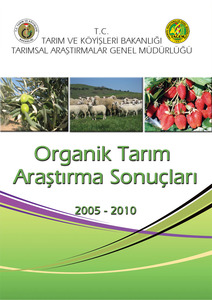Erdal, Ülfet; Sökmen, Ömer; Üner, Kürşat; Bilir, Lamia; Göçmez, Selçuk; Okur, Nur; Okur, Bülent; Anaç, Dilek; Ongun, Ali Rıza; Ertem, Atila and Çakmak, Reşat (2010) Pamuk Yetiştiriciliğinde Organik ve Konvansiyonel Tarım Uygulamalarının Verim, Kalite ve Toprak Özellikleri Üzerine Etkileri. [The effects of Organic and Conventional Farming Practices on Yield, Quality and Soil Properties in Cotton Growing.] In: Alay Vural, Ayşen (Ed.) Organik Tarım Araştırma Sonuçları. T.C. Tarım ve Köyişleri Bakanlığı, Ankara, Turkey, pp. 325-332.
![[thumbnail of Organik tarim kapak.jpg]](/22126/1.hassmallThumbnailVersion/Organik%20tarim%20kapak.jpg)  Preview |
Image (JPEG)
- Published Version
- Turkish/Türkiye
174kB |
Preview |
PDF
- Published Version
- Turkish/Türkiye
683kB |
Document available online at: http://www.tagem.gov.tr
Summary in the original language of the document
Konvansiyonel ve organik tarım sistemlerini karşılaştırmak ve bu iki farklı sistemin, toprağın fiziksel, kimyasal, mikrobiyolojik dinamiği, lif kalitesi, verimdeki değişimi, yaprakların makro, mikro element kapsamları ve katkı kalıntının etkisini belirlemek amacıyla yapılmış bir çalışmadır. 2002-2008 yılları arasında 7 yıl süre ile Menemen’de pamuk+pamuk+buğday münavebe sisteminde yürütülmüştür. Organik parsellere toprak analiz sonuçları değerlendirilerek bitki besleme materyali olarak organik sertifikalı gübre, yeşil gübre kullanılmıştır. Konvansiyonel parsellere ise %21’lik amonyum sülfat ile %26’lık amonyum nitrat, fosforlu gübre olarak %43’lük triple süper fosfat ve potasyumlu gübre olarak %48-52’lik potasyum sülfat uygulanmıştır. Organik parsellerde bitki koruma materyali olarak Organik Tarım Kanununda izin verilen preparatlar, konvansiyonel parsellere ise üründe ruhsatlı olan sentetik preparatlar kullanılmıştır. 7 yılın toprak analiz sonuçları değerlendirildiğinde su ile doymuşluk, kireç, tuz, pH ve potasyum değerlerinde her iki sistemde de bir farklılık göstermemiştir. Fosfor değerleri konvansiyonel tarımda bir artmış, organik madde konvansiyonel tarım sisteminde daha yüksek gibi görünse de mikrobiyolojik aktivite ve enzim faaliyetleri organik parsellerde daha fazla faaliyet gösterdiği için bu sonuç elde edilmiştir. Topraktaki mikroelementlerde F ve Cu değe her iki sistemde değişmemiştir Mn her iki sistemde artışmış, Zn değerleri ise her iki sistem çok yeterli olmadığı saptanmıştır. Hacim ağırlık değerleri organik tarım lehine çıkmıştır. Stürüktür stabilite indeksi her iki sistem arasında istatistikî anlamda organik tarım lehine önemli bulunmuştur. Pamukta yapraklarında bulunan N,K,Ca, Cu, Mn, ve Zn mikroelementlerinde iki sistem arasında fark çıkmış, P,Mg ve Fe istatistiki anlamda bir fark çıkamıştır. Her iki sistemden elde edilen kütlü verimleri karşılaştırıldığında organik ve konvansiyonel tarım sistemleri arasındaki verim farkı istatistikî olarak önemsiz bulunmuştur. Organik ve konvansiyonel sisteme ait kalite kriterlerinden lif uzunluğu, uniformite indeksi, kısa lif indeksi, lif kopma dayanıklılığı, lif kopma uzaması ve lif olgunluğu değerleri arasındaki farklılıklar istatistikî olarak önemsiz bulunurken, lif inceliği ve çırçır randımanı değerleri arasındaki farklılıklar önemli bulunmuştur.
Münavebe bitkisi buğday da verim değerleri istatistikî anlamda konvansiyonele tarım lehine çıkmış, ancak kalite kriterlerinden bin dane ağırlığı organik lehine istatistiki anlamda farklı çıkmıştır. Hektolitre ağırlında ise sistemler arasında fark önemsiz bulunmuştur. Mikrobiyolojik aktiviteler ve enzimler organik tarım alanlarda her iki derinlikte (0-20ve 20-40cm) de daha yüksek değerlere sahiptir. Kalıntı analizlerinde organik parsellere çevresel bulaşmaya rastlanmamıştır. Konvansiyonel parsellerde sadece bir yıl kalıntıya rastlanmış ve limit değerlerinin altında saptanmıştır.
Summary translation
In this study, it is aimed to compare the effects of physical, chemical and microbiological dynamics of soil on fiber quality, yield, micro and macro element contents of leaves and residual effects on fiber in organic and conventional farming systems The experiment was carried out in cotton-cotton-wheat rotation system in 5 replicates completely randomized design in Menemen between 2002-2008, 7 year long. According to soil analysis results, certified fertilizer and green manure were applied as plant nutrition material in organic plots. On the other hand, 21% ammonium sulphate, 26% ammonium nitrate, 43% triple super phosphate as P2O5 and 48-52% potassium sulphate as K2O were applied in conventional plots. Certified products and traps permitted in the related regulations were used as plant protection material in organic plots. In conventional plots, synthetic chemicals were used. According to soil analysis results in 7 years, saturation, lime, salinity, pH and potassium values were not differed in both systems. P values were increased in conventional plots. Seemingly, organic matter was higher in conventional plots, but due to high microbiological and enzyme activities, lower levels of organic matter were determined in organic plots. In both farming systems, among micro elements, Fe and Cu values of the soil, were not changed. Mn was increased in both systems; on the other hand Zn values were below adequate levels. Soil bulk densities and structure stability indexes were statistically significant in organic plots. While N, K, Ca, Cu, Mn and Zn microelement contents of cotton leaves were found different between two farming systems, P, Mg and Fe were not statistically significant. According to the statistical analysis, no significant differences were found between organic and conventional growing systems in terms of cotton yields. Likewise, between the growing systems, fiber length (mm), uniformity index, short fiber index, fiber strength, fiber elongation and fiber maturity criteria were not different, however, the differences in micronaire and ginning rate were found statistically significant.
In rotation crop, wheat, thousand grain weight and yield were statistically significant in organic plots. But hectolitre weigth was not significant. Microbiological activities and anzyme activities were higher in both depth levels of soil (0-20 and 20-40cm) in organic plots There was no residual environmental contemination in organic plots. On the other hand, there was only one year residula contamination on the fiber but below allowed limit in conventional system
| EPrint Type: | Book chapter |
|---|---|
| Keywords: | cotton, soil, toprak, pamuk |
| Subjects: | "Organics" in general Soil > Soil quality Soil > Nutrient turnover Farming Systems > Farm nutrient management |
| Research affiliation: | Turkey > Ege University Turkey > Other organizations Turkey Turkey > Turkey National Organic Agriculture Research Institutes (TAGEM) Turkey |
| Related Links: | http://www.utaem.gov.tr/, http://www.ege.edu.tr, http://www.rapunzel.com.tr |
| Deposited By: | VURAL, Dr. Aysen ALAY |
| ID Code: | 22126 |
| Deposited On: | 07 Jan 2013 12:59 |
| Last Modified: | 07 Jan 2013 12:59 |
| Document Language: | Turkish/Türkiye |
| Status: | Published |
| Refereed: | Not peer-reviewed |
Repository Staff Only: item control page

 Download Statistics
Download Statistics Download Statistics
Download Statistics
